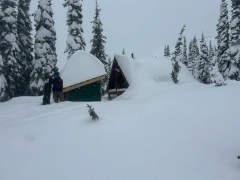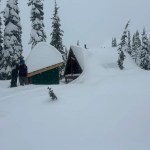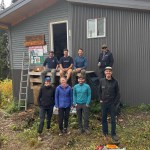Tunnel Creek Incident Report
Fernie SAR was activated today for a report of an injured skier. The skier, part of a group of six skiers based at Tunnel Creek Cabin, were involved in an avalanche triggered by a cornice in the 1942 Chute area. One skier fell an estimated 200 metres through challenging terrain, sustaining a chest injury.
The group was well-prepared and was able to summon help and begin evacuating the injured person, a 22 year-old male from the Fernie area.
Fernie SAR responded with two SAR Techs on snowmobiles and via helicopter. The subject was brought out to BCAS on the Highway via snowmobile.
While this rescue would have been made quicker and simpler had we been able to use our longline rescue capability, it was a good reminder that wilderness rescue depends on the resources available on any particular day.
The avalanche hazard was rated as moderate in the Alpine today however Avalanche Canada stated, “Triggering avalanches remains possible where winds have drifted the recent snow into slabs. Seek out sheltered slopes and monitor for these conditions if travelling in wind-exposed areas.” BE safe and follow the current Avalanche Bulletin on Avalanche.ca
Fernie Search and Rescue is a wilderness emergency response group that acts on behalf of Emergency Management BC.
The group is comprised of volunteers who assist people in emergencies in the backcountry. Fernie Search and Rescue can be tasked by various agencies, including the RCMP, the British Columbia Ambulance Service or BCAS, Fire /Rescue, local municipalities and the Department of National Defence.
Members of the public needing a SAR response should call 911, ask for the RCMP or BCAS and state that the nature of the emergency is in the backcountry and needs a SAR response.
Tunnel Creek Incident report
A party of 6 people (2 skiers, 4 split boarders) were ski touring the tunnel creek area, stationed at the tunnel creek hut. The party rode sunnyside on Sunday January 26th and camped in the hut overnight. On Monday January 27th they skinned up sunnyside and descended into mercury bowl, skinned north and ascended back up sunnyside ridge.
Snowpack was stable with a 2-3cm crust on almost all faces and elevations, including most of sunny side ridge.
Overnight accumulation totalled 7cms of dry gropple snow. Some sluffing was observed, but minimal.
The group then headed north along the ridge, when at approximately 1:30pm a skier, stepped over to look down the east facing slopes of 1942 chutes and was swept down a tight chute when the cornice (the size of a short bus) he was standing on gave way. He was taken 200 meters down the slope before coming to a stop. Both skis were dislodged, along with his poles and gloves.
Google Earth shows a max grade of 79% in the chute.
The remaining 5 in the party were safe atop the ridge and, after reaching the skier via radio, determined he was conscious and not buried. The group determined a safe route down to the skier and proceeded to descend one at a time to the skiers location. Radio contact between the sub groups within the party was an asset. Upon arrival to the patient, he received a full body scan, where it was determined he had sustained an impact to his front and left lower abdomen. The patient was conscious, and was confident he had not hit his head in the fall. An emergency blanket was wrapped around him, along with some extra clothing, hand warmers were placed around his abdomen.
After it was determined safe enough to explore, 2 members of the party descended along the side path to locate the patients missing gear, as his skis and skins would be an asset to evacuation. One ski was found suspended in a small tree 10 meters up slope from the patient, the remaining gear was found another 200 meters down the slide path. Only one ski pole was not found.
Approximately 5 minutes after assessing the patient, 911 was contacted. A 14 minute conversation was required to relay incident information. 911 informed the caller that Fernie SAR would contact them within 20 minutes.
As the group of 2 were locating lost gear, the patient experienced shortness of breath, as well as bouts of shivering. He was given tang and wine gums.
After 30 minutes of warming the patient, he was given 800mg of liquid ibuprofen capsules, which reduced his reported pain, as well as relaxed him. The patient was conscious and lucid.
At around 3:00pm, the party had gathered the patients gear and the patient reported confidence in an unsupported evacuation. The party traversed multiple slide paths to reach the run known as “beyond awesome” which terminated into a gully and eventually a Forest Service Road. The evacuation totalled 1.65km, 565 meter descent, 42 meter ascent, average slope of 35%, with maximum slopes of -67% and +40%
The patient remained fairly stable throughout the descent, but began to experience fatigue, as his breathing was compromised by 5 broken ribs and a punctured left lung (he also had a ruptured spleen). At the time, the party assumed that he had taken in snow during the slide, causing his breathing issues. It wasn’t until arrival at Cranbrook Hospital that his injuries were diagnosed. Upon arrival at the ambulance in the tunnel creek parking lot, paramedics identified a highly compromised right lung, a partial collapse of the lower left lung, and bleeding into the stomach. He was administered a clotting medication to slow the bleeding in the stomach.
During the traverse and descent, a member of the party was able to send and receive text messages with SAR through intermittent service zones. A meet point was established and SAR was told an attempt would be made to arrive at the meet location (Tunnel Creek FSR) unassisted.
The patient was able to independently descend the slopes in increments of 20-30 meters. He was unable to effectively kick turn or snowplow, so had to descend in slow and controlled maneuvers. Once in the gully descent became slower as heavy snow, lowered patient energy, and high risk terrain traps were navigated.
The man then had to avoid falling into the narrow creek gully, holding onto willow branches and moving very slow. At the farthest visible point of the creek bed in the below image, the man became tired and an attempt to push him on a snowboard was made, this advanced him about 20 meters, but was ineffective. After a brief rest and some assessment of the snow under foot, it was determined the man could walk with assistance the remainder of the stretch to the FSR where SAR then transported him by snowmobile to the hwy 3 parking lot south of the hwy 3 tunnel. The man remained stable and was assessed by paramedics on site before being transported to Cranbrook Regional Hospital.
After many hours of casual debriefing and conversation, the party determined that the primary cause of the incident was human error (standing too close to a cornice edge) and that healthy respect for cornices, as well as conservative traverse routes along wind loaded ridges was the best way to avoid similar situations in the future. The party also determined that the social dynamics of larger groups warrant a slower and more conservative approach to ski touring logistics than do expeditions with 2 or 3 members.
Source: Facebook
Tags: Fernie trails, tunnel creek accident report, tunnel creek avalanche, Tunnel Creek Incident Report






































